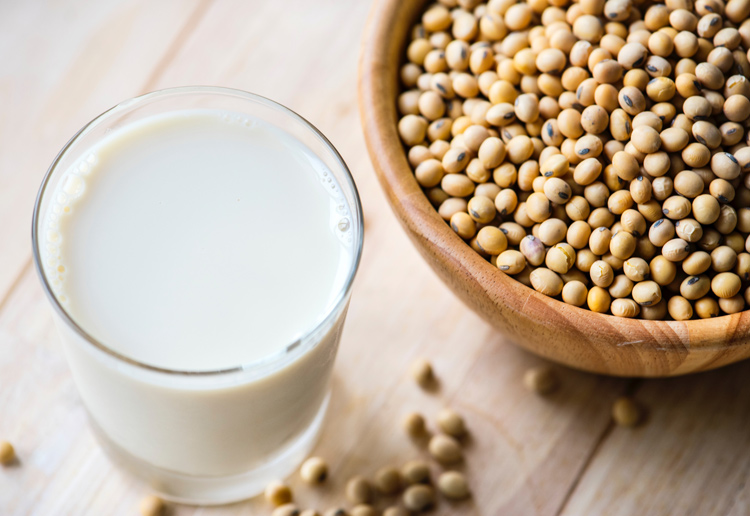Milk’s Health Benefits, Allergies, and Alternatives

Drinking milk has been part of our lives since we were born. We drank our mother’s breast milk to nourish our fragile, little bodies. Even when babies have transitioned to toddlerhood, some mothers continue to breastfeed as long as their “liquid gold” can be produced.
In my case, I only got to breastfeed my daughter for a few months because I wasn’t able to produce enough milk. It didn’t matter how many supplements I took or breast milk-boosting foods I ate. That is why I alternately gave breast milk and formula milk to my baby and shifted permanently to the latter.
Thankfully, my daughter has no milk allergies or intolerances whatsoever. Even now that she is two-going-on-three-years-old, she sometimes prefers drinking milk to eating food (but she does eat meals every day). Most of the time, however, she drinks milk and then I just find her asleep on her bed. She really does love her milk
Table of Contents
- 1 Benefits of milk
- 2 Milk improves your skin’s complexion
- 3 Milk aids in muscle growth
- 4 Milk may help in weight loss
- 5 Milk may help you relax
- 6 Milk helps prevent certain diseases
- 7 What is Milk Allergy?
- 8 Milk Allergy vs. Lactose Intolerance
- 9 Milk Alternatives
- 10 Soy Milk
- 11 Almond milk
- 12 Rice milk
- 13 Coconut milk
- 14 Hemp Milk
- 15 In summary
- 16 Author Bio:
- 17 Related Posts
Benefits of milk
Drinking milk is important to our health. Since we were kids, we have been taught to drink our milk. We have loved milk, especially when we poured it on our favorite cereals or dipped cookies in it. Our school cafeterias also offered small milk cartons along with lunch.
Basically, milk is like the staple beverage of our childhood – and most probably until now. Milk has a lot of health benefits for both children and adults, aside from making our bones and teeth strong. Among these amazing benefits are:
Milk improves your skin’s complexion
Who doesn’t like to have great skin? Cleopatra reportedly took milk baths to achieve this. Milk contains a lot of essential nutrients and vitamins that help improve skin health. No wonder many skin care products contain milk. Drinking milk also provides similar benefits.
Milk aids in muscle growth
Aside from calcium, milk also contains protein that is essential for muscle growth. It also helps in preventing muscle soreness and restoring lost fluids due to physical activities.
Milk may help in weight loss
According to studies, women have a higher chance of losing weight when they drink milk. Drinking milk makes you feel full so you eat less.
Milk may help you relax
While there’s little evidence that it will actually put you to sleep, the ritual of drinking a warm glass of milk before going to bed may help you to sleep due to associations with childhood or by distracting the mind. Milk helps relieve stress and stress-related body pains. It may also help to alleviate PMS symptoms.
Milk helps prevent certain diseases
Milk is said to aid in lowering blood pressure and reduces the risk of having a stroke. It can also improve eyesight, prevent heartburn, promote the production of cholesterol, and even reduce the risk of certain cancers.
What is Milk Allergy?
Given all of these health benefits, it is a must for most people to include milk in their everyday diet, but not all. Some people may suffer adverse effects from drinking milk. Yes, there is such a thing as having a milk allergy.
The type of milk most of us have consumed our entire lives comes from animals, such as cows, goats, sheep, and even camels. While their milk provides a lot of health benefits, some people are not able to consume them due to health reasons. One of these reasons is a milk allergy.
Milk allergy is often caused by either the alpha S1-casein or whey protein present in cow’s milk, which results in certain immune reactions. Cow’s milk is one of the top causes of childhood allergies, followed by eggs, nuts, grain, and seafood.
Statistics reveal that around two to three percent of children under 3-years-old are found to be allergic to milk. Most children outgrow this allergy, though sometimes it doesn’t manifest until adulthood. Allergic reactions from drinking milk usually happen shortly after consumption. Among the common symptoms of a milk allergy are:
- Wheezing
- Vomiting
- Digestion problems
- Hives
- Itching or tingling sensation around the lips or mouth
- Shortness of breath
- Coughing
- Loose or even bloody stools
- Abdominal cramps
- Watery eyes and nose
- Colic (in babies)
In the worst cases, a person suffering from milk allergy may experience:
- Anaphylaxis: A severe, possibly life-threatening reaction that may include constriction of the airways and a swollen tongue or throat, which can make breathing difficult
- Face flushing
- A drop in blood pressure
Once you notice these symptoms, rush to the nearest clinic or hospital for further diagnosis and evaluation. Don’t wait and be sorry later, especially if the sufferer is your child.
Milk Allergy vs. Lactose Intolerance
A less severe milk sensitivity is lactose intolerance. The two terms are often—and incorrectly—used interchangeably.
According to Food Allergy Research and Education (FARE), a food allergy occurs once your immune system reacts to a certain food protein and can be life-threatening if left unattended.
On the other hand, your immune system has nothing to do with when a lactose intolerance occurs. Lactose intolerant individuals lack an enzyme called lactase that helps break down lactose, a type of sugar present in milk and other dairy products.
Lactose intolerant individuals experience digestion problems, gas, diarrhea and overall discomfort in their tummy area. Studies reveal that around three-fourths of the world’s population is lactose intolerant. Fortunately, lactose intolerance does not cause life-threatening symptoms as compared to milk allergies.
For both the milk allergic and the lactose intolerant, to prevent the occurrence of the above symptoms, it is important to read the label carefully to avoid foods that contain dairy.
Milk Alternatives
If you are either lactose intolerant or have a milk allergy, but still crave a milk-like experience, there are many milk alternatives from which to choose. Since these milk alternatives are plant-based, they do not contain any of the enzymes or proteins present in animal-based milk to trigger intolerance or allergies.
These milk alternatives vary in taste, color, texture, and nutritional content and levels. They are readily available on the market and are promoted as healthier alternatives for health-conscious individuals.
Here are the most common dairy-free, plant-based milk alternatives:
Soy Milk
Soy milk is one of the most popular milk alternatives around. It is either extracted from soybeans or soy protein isolate. Thickeners and vegetables are added to improve texture, consistency, and flavor.
It is sold in various forms: sweetened, unsweetened, and flavored. Among popular soy milk flavors are chocolate, strawberry, vanilla, and even melon. You can enjoy it with your cereal, as a replacement for coffee creamer, or by the glass.
- Benefits: Soy milk contains calcium, vitamins A and D, riboflavin, and protein. It is low in calories, fat, and carbs. It is a preferred workout drink by many gym buffs due to its high protein content. In addition, it contains isoflavones which reduce the risk of heart disease and breast cancer, along with phytoestrogens that can be beneficial to menopausal women.
- Downsides: Soy milk is not recommended for those who have nut allergies. Technically, soybeans belong to the legumes family, which also includes peanuts. It also can affect an individual’s estrogen levels due to its high isoflavone content, (though there is no scientific evidence—despite repeated claims to the contrary—that soy will make a man more “feminine”). Even organic food advocates emphasize that soy milk should never be substituted for breast milk because it lacks certain essential nutrients for child development and growth.
Almond milk
As the name suggests, this type of animal milk alternative is made from almonds, specifically from whole almonds, or a combination of almond butter and water, plus sweeteners. It also has a creamy texture similar to cow’s milk. After soy milk, almond milk is the healthiest non-dairy milk choices.
- Benefits: Like cow’s milk, almond milk can be a great addition to coffee and tea, as well as mixed with smoothies and desserts. It is also low in calories, fat, and carbs. It is a great source of vitamin E. To enjoy the health benefits of almond milk, look for one that has between 7 and 15 percent almond content.
- Downsides: Almonds contain phytic acid, which hinders mineral absorption in our bodies. It is also not recommended for people with nut allergies. Aside from that, almond milk lacks the essential vitamins, minerals, and fatty acids dairy milk has, as well as protein, fiber, and healthy fats. Most almond milk products are mostly water. Moreover, the almonds used are blanched and the skin removed, which eliminates most of its fiber, protein, and other important nutrients.
Rice milk
Rice milk is often made from boiled rice, brown rice syrup, and brown rice starch. It contains high levels of carbs and calories. Unlike dairy milk and the first two alternatives, rice milk has a thin and watery consistency that makes it not recommended for use as a milk substitute in food recipes.
- Benefits: If you are lactose intolerant or allergic to milk and nuts, rice milk is your best bet. Among all milk alternatives, rice milk is the most hypoallergenic because it’s soy-free, gluten-free, nut-free, and dairy-free. It also contains calcium, magnesium, potassium, and vitamin A.
- Downsides: Rice milk has a high carbohydrate content and so is not recommended for those who are watching their weight. It is not suitable for diabetics either due to its high glycemic index content. It also has low protein content, thus is not recommended for growing children and older people. Most alarming is that rice milk is said to have high arsenic levels, which increases the risk of heart disease and certain cancers.
Coconut milk
Coconut milk is perhaps the closest to dairy milk in terms of texture. It is made from water and coconut flesh. It is especially common in Indian and Southeast Asian dishes and is often sold in cans or cartons. Click here for coconut milk recipes.
- Benefits: Aside from being a great ingredient in Asian dishes and baked goods, coconut milk is gluten-free and soy-free. In addition, coconut has more potassium per cup than dairy milk. While it lacks protein, it is recommended for people who are monitoring their carb intake. Plus, coconut milk contains a type of saturated fat called medium-chain triglycerides or MCTs which can aid in weight loss and blood cholesterol improvement.
- Downsides: On the flip side, coconut milk lacks the nutritional value present in dairy milk such as protein and calcium. Another thing is that coconut milk may increase LDL cholesterol (a.k.a “bad” cholesterol) more than unsaturated oils.
Hemp Milk
No, this will not get you high. While it’s true that hemp milk is made from the seeds of Cannabis sativa (a.k.a. marijuana), the seeds contain only negligible amounts of tetrahydrocannabinol (THC), the chemical in marijuana that makes you “high” when you use it.
Hemp milk is made from hulled hemp seeds, water, and sweeteners. It tastes slightly sweet and nutty, with a thin and watery texture. It is a great alternative to skim milk.
- Benefits: Hemp milk is perfect for vegans and vegetarians because it contains a high amount of protein. Likewise, it is great for those who are monitoring their carbs intake (unsweetened variety). Hemp milk is also meant for people allergic to soy, nuts, and gluten. It contains higher levels of iron than cow’s milk and is high in the omega-3 fatty acids that boost brain and cardiovascular health.
- Downsides: Unless fortified, hemp milk is naturally low in calcium. Most hemp milk available in stores is quite costly and the sweetened variety contains sugar.
These are only the most common milk alternatives on the market for those who are lactose-intolerant or allergic to dairy milk. If none of these appeals, here are some others:
In summary
Dairy milk is a nutritional drink that should be incorporated into our daily diet unless you are lactose-intolerant or allergic. Thankfully there are many milk alternatives now that can match your taste, health, and dietary needs.
In choosing the right milk alternative, it’s important to check its nutritional content. Ask yourself:
- Does it have loads of sugar?
- Does it contain high amounts of calcium?
- Does it suit my vegetarian/vegan lifestyle?
- Is it affordable or expensive?
By incorporating more milk into our diet—whether dairy or plant-based—we all can enjoy the health benefits they provide.
Author Bio:

Nicole is a freelance writer and educator based in the Michigan and believes that her writing is an extension of her career as a tutor. She covers many topics like travel, mental health and education. She is a key contributor to Chapters Capistrano’s website where she covers topics like addiction recovery, dual diagnosis treatments and health education. When she isn’t writing, you might find Nicole running, hiking, and swimming. She has participated in several 10K races and hopes to compete in a marathon one day.



Rice milk is really good.